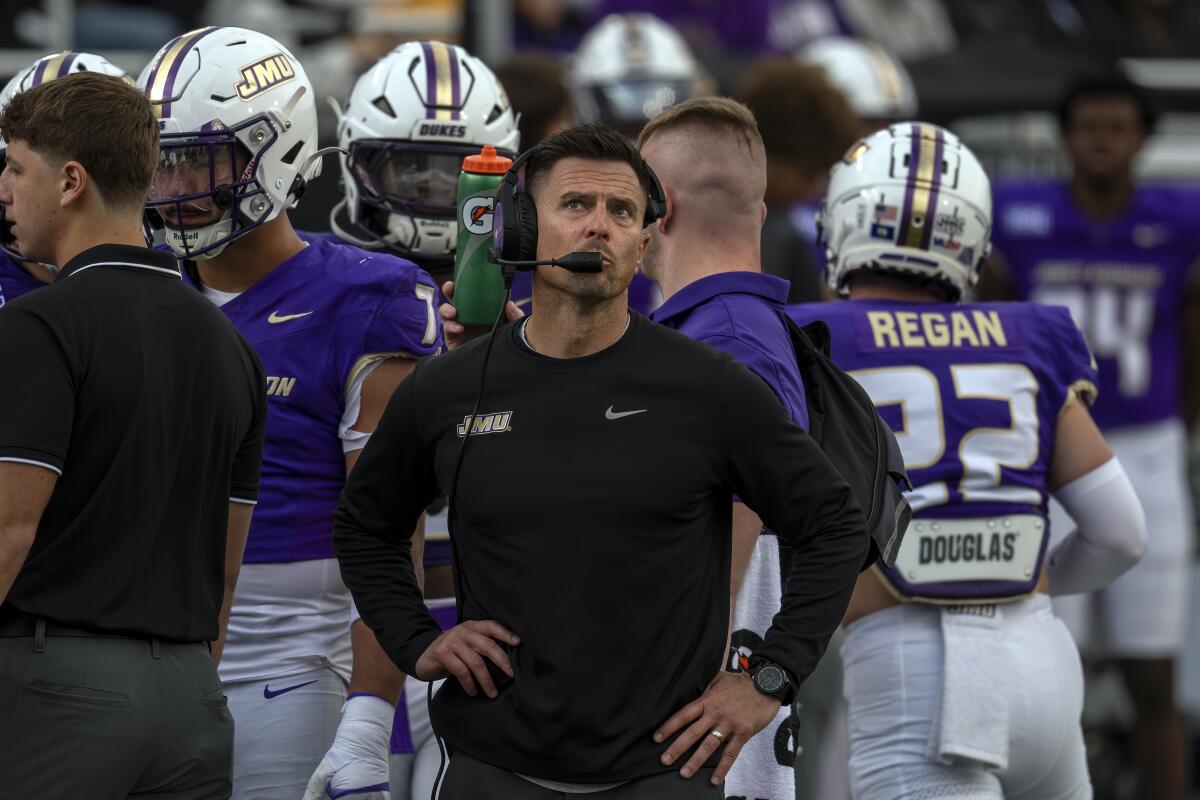UCLA to hire Bob Chesney as its next head football coach
Operating out of a different playbook than it used nearly two years ago, when it made a vastly underwhelming hire, UCLA has snagged one of the most promising football coaches on the market.
Ending a pursuit that had become increasingly hard to keep quiet in recent weeks, the Bruins are set to hire James Madison coach Bob Chesney on a five-year contract in a move first reported by ESPN’s Pete Thamel. As part of the arrangement, Chesney is expected to remain with his current team through a possible College Football Playoff appearance with the Dukes.
The move represents a dramatic shift for a program in desperate need of a turnaround, the Bruins going with an up-and-coming coach who has won big everywhere he’s been as part of his own storybook rise. UCLA athletic department officials would not confirm the imminent hire that’s expected to be announced after James Madison plays Troy in the Sun Belt Conference championship game on Friday.
After massive success at the Division III, Division II, Football Championship Subdivision and Football Bowl Subdivision levels, Chesney now takes on his greatest challenge — reviving a Big Ten team that hasn’t achieved anything of national significance in more than a quarter of a century.
Winning at the Power Four level is the only hole in Chesney’s résumé. Hugely successful stints at small college programs Salve Regina and Assumption led Chesney to Holy Cross, where he guided the Crusaders to five consecutive Patriot League championships and four appearances in the FCS playoffs, including their first trip to the quarterfinals in 40 years.

James Madison coach Bob Chesney watches his team play Washington State at Bridgeforth Stadium on Nov. 22.
(Brien Aho / Getty Images)
The joy ride picked up momentum when Chesney replaced Curt Cignetti at James Madison. After a debut 2024 season in which his team went 9-4, Chesney has guided the Dukes to a 11-1 record this season while going unbeaten in the Sun Belt Conference, putting them in contention for a College Football Playoff bid.
Chesney’s core philosophies include fostering a growth mindset and instilling confidence through competitions in which the celebrations are judged as closely as what happens on the field.
“To me,” Chesney said in a video for the Harbaugh Coaching Academy, “it’s that ability to celebrate little successes and then you watch someone just kind of sit up a little taller, swell up a little bit more with pride and then they want to build that confidence, they want to repeat that success.”
Having won over UCLA’s coaching search committee with an outgoing, charismatic personality, the 48-year-old Chesney now must go about using those same traits to woo donors and recruits. UCLA’s name, image and likeness endeavors are transitioning to new leadership and Chesney must play a huge role in landing the sort of money the Bruins will need to compete in the Big Ten. A native of Pennsylvania, he’ll also have to establish roots in new territory after having spent his entire life on the East Coast.
He starred as a second-team all-conference defensive back at Dickinson College, where he majored in religion. Chesney mostly coached on the defensive side of the ball in his early stints as an assistant, rising to defensive coordinator at Johns Hopkins. But his teams are known for being well-rounded — James Madison averages 37.8 points, ranking No. 10 nationally, while giving up 16 points, also ranking No. 10.
Chesney replaces DeShaun Foster, who was fired only three games into the season after having compiled a 5-10 record at his alma mater. The hiring of Chesney represented a vast departure from the strategy UCLA secured to select Foster, a position coach not on anyone else’s short list as a head coaching candidate.
Chesney is the first sitting head coach the Bruins have picked since convincing Pepper Rodgers to leave Kansas before the 1971 season. Rodgers compiled a 19-12-1 record over three seasons at UCLA before leaving for Georgia Tech, his alma mater.
Luring head coaches from other places has historically been a winning move for UCLA. Tommy Prothro left Oregon State to go 41-18-3 at UCLA — including a victory in the 1966 Rose Bowl — before landing a job with the Rams.
Red Sanders departed Vanderbilt — his alma mater — to embark on a golden era of football at UCLA, guiding the Bruins to a 66-19-1 record and a share of the Bruins’ only national championship, in 1954. One can only imagine how different the trajectory of UCLA football might have been had Sanders not died from a heart attack before the 1958 season.
Going with an established head coach in Chesney could have the extra benefit of providing cover for UCLA athletic director Martin Jarmond after his failed hiring of Foster. The Bruins finished the season with a 3-9 record under interim coach Tim Skipper after a 29-10 loss to crosstown rival USC. Jarmond presided over a search committee that also included sports executive Casey Wasserman, former Golden State Warriors general manager Bob Myers, Washington Commanders general manager Adam Peters, UCLA executive senior associate athletic director Erin Adkins and former Bruins star linebacker Eric Kendricks.
As a reminder of what’s at stake for its long-suffering fan base, UCLA is approaching the 40-year anniversary of its last Rose Bowl game victory, over Iowa on Jan. 1, 1986. The Bruins have not appeared in a Rose Bowl game since 1999, at the end of a season in which they won their last conference championship.
If all goes well, the coach secured with a proven approach could lead to a return to happier days.
